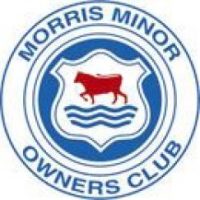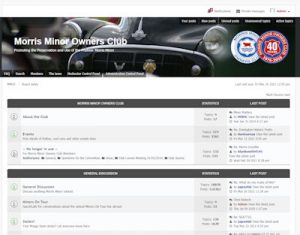The original Minor MM series was produced from 1948 until 1953. It included a pair of four-seat saloons, two-door and (from 1950) a four-door, and a convertible four-seat Tourer. The front torsion bar suspension was shared with the larger Morris Oxford MO, as was the almost-unibody construction. Although the Minor was originally designed to accept a flat-4 engine, late in the development stage it was replaced by a 918 cc (56.0 cu in) side-valve inline-four engine, little changed from that fitted in the early 1930s Morris Minor and Morris 8, with a bore of 57 mm but with the stroke of 90 mm and not 83 mm, and producing 27.5 hp (21 kW) and 39 lbf·ft (50.3 N·m) of torque. The engine pushed the Minor to just 64 mph (103 km/h) but delivered 40 miles per imperial gallon (7.1 L/100 km; 33 mpg‑US). Brakes were four-wheel drums.
Early cars had a painted section in the centre of the bumpers to cover the widening of the production car from the prototypes. This widening of 4 inches (102 mm) is also visible in the creases in the bonnet. Exports to the United States began in 1949 with the headlamps removed from within the grille surround to be mounted higher on the wings to meet local safety requirements. In 1950 a four-door version was released, initially available only for export, and featuring from the start the headlamps faired into the wings rather than set lower down on either side of the grille. The raised headlight position became standard on all Minors in time for 1951. From the start, the Minor had semaphore-type turn indicators, and subsequent Minor versions persisted with these until 1961. An Autocar magazine road test in 1950 reported that these were “not of the usual self-cancelling type, but incorporated a time-basis return mechanism in a switch below the facia, in front of the driver”. It was all too easy for a passenger hurriedly emerging from the front passenger seat to collide with and snap off a tardy indicator “flipper” that was still sticking out of the B-pillar, having not yet been safely returned by the time-basis return mechanism to its folded position. Another innovation towards the end of 1950 was a water pump (replacing a gravity dependent system), which permitted the manufacturer to offer an interior heater “as optional equipment”.
When production of the first series ended, just over a quarter of a million had been sold, 30% of them the convertible Tourer model.
A 918 cc-engined tourer tested by the British magazine The Motor in 1950 had a top speed of 58.7 mph (94.5 km/h) and could accelerate from 0–50 mph (80 km/h) in 29.2 seconds. However, the 918 cc engine did 0–60 mph in 50+ seconds. A fuel consumption of 42 miles per imperial gallon (6.7 L/100 km; 35 mpg‑US) was recorded. The test car cost £382 including taxes.



